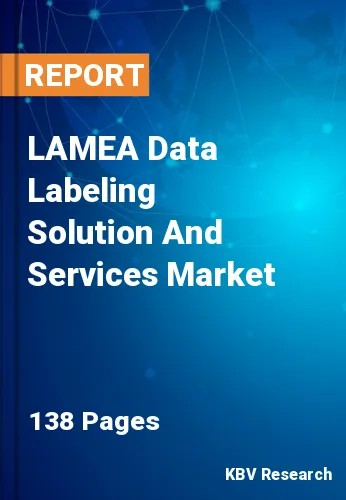The Latin America, Middle East and Africa Data Labeling Solution And Services Market would witness market growth of 23.7% CAGR during the forecast period (2023-2030).
Several use cases exist for generative AI in data labeling, where it can lessen the amount of manual labor needed to annotate massive datasets. For instance, generative models like GANs can produce bounding boxes or masks around certain objects in an image. It makes image segmentation jobs more effective by lowering the manual labor to annotate huge datasets. For instance, a U.S.-based firm called OpenAI debuted DALL-E in January 2021, a generative AI model that can produce visuals from verbal descriptions. This technique can be applied to data labeling by creating graphics for certain datasets, minimizing the amount of manual labor necessary for labeling.
Additionally, machine learning systems are frequently used to categorize data objects like tweets or news articles. This, in turn, necessitates a particular annotated training dataset, assisting in automatically creating algorithms that categorize new data objects. However, creating such a dataset by hand is a challenging task requiring much effort from the coders. Clinical data collection, which consists primarily of unstructured text documents, has grown in importance as health record systems (HER) use has grown. Statistical NLP (natural language processing) standards have been created to reveal data hidden in clinical literature.
The UAE government predicts the Middle East ICT market to expand from USD 84.23 billion in 2020 to USD 95.05 billion in 2025 at a compound annual growth rate (CAGR) of 2.4%. The Middle East's IT industry is continuously expanding as countries' budgets in 2019 amounted to USD 207 billion. As the Middle East region's fastest-growing technology industry, software spending grew by 11% yearly to a record-high of USD 6.2 billion in 2018. According to predictions, the adoption of AI in computer vision in the MEA will rise from USD 310.71 million in 2019 to USD 5,210.41 million in 2027, expanding at a CAGR of 43.2% over that time. The growth of the market in this region will accelerate as spending on AI technologies rises.
The Brazil market dominated the LAMEA Data Labeling Solution And Services Market by Country in 2022, and would continue to be a dominant market till 2030; thereby, achieving a market value of $1.0 billion by 2030. The Argentina market is experiencing a CAGR of 24.3% during (2023 - 2030). Additionally, The UAE market would register a CAGR of 23.3% during (2023 - 2030).
Based on Type, the market is segmented into Image/Video, Text, and Audio. Based on Labeling Type, the market is segmented into Manual, Semi-Supervised, and Automatic. Based on Sourcing Type, the market is segmented into Outsourced, and In-House. Based on Vertical, the market is segmented into IT, Automotive, Financial Services, Government, Healthcare, Retail, and Others. Based on countries, the market is segmented into Brazil, Argentina, UAE, Saudi Arabia, South Africa, Nigeria, and Rest of LAMEA.
Free Valuable Insights: The Worldwide Data Labeling Solution And Services Market is Projected to reach USD 46.9 Billion by 2030, at a CAGR of 19.5%
The market research report covers the analysis of key stake holders of the market. Key companies profiled in the report include Google LLC (Alphabet Inc.), Appen Limited, TELUS International (Playment, Inc.), Yandex N.V., Uber Technologies, Inc. (Mighty AI, Inc.), Zight, Alegion, Inc., Scale AI, Inc., Labelbox, Inc., Cogito Tech LLC
By Type
By Labeling Type
By Sourcing Type
By Vertical
By Country
Our team of dedicated experts can provide you with attractive expansion opportunities for your business.

